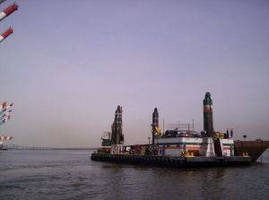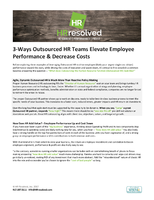Monitoring Engines & Emissions in New York Harbor

DataTaker Solution Helps Keep the Waterway Open for Business
CHESTERLAND OH — A considerable amount of the seagoing freight entering the US comes through one of the world's largest natural harbors--New York Harbor. Keeping the harbor navigable is a full-time job that requires constant dredging to allow large oceangoing vessels safe access to the freight terminal. Each of these dredging barges utilizes multiple diesel engines to run its generators, its crane and other equipment. Dredging operations are overseen by the EPA and the Army Corps of Engineers. It's essential for barge crews to continually monitor these large engines and record CO2 and other emissions to maintain operations and also avoid potential fines for exceeding EPA emissions regulations.
In March of 2011 CAS DataLoggers provided the DataTaker engine monitoring solution for R.A. Mitchell Co. Inc, an emergency generator and marine services dealer with a customer operating one of these dredge barges. R.A. Mitchell's customer needed "a bulletproof way to get the data," specifying that they wanted all the engine data in one format so workers would only have to use a single procedure for all their different types of equipment.
Datalogger and Sensors:
To provide continuous monitoring of the diesel engines, each engine is fitted with a dataTaker DT80 Data Logger and where appropriate, a CANgate CANbus to Serial Gateway. At a minimum, both run time and fuel consumption are recorded for each engine. When applicable, the dataTaker also monitors engine RPM, engine load and coolant temperatures in order to evaluate engine performance.
On the barge's newer engines, all of these parameters are typically available from the engine ECU via the CANbus. For example in the barge's crane cab, a dataTaker DT80 and CANgate are installed in a control cabinet located near the operator's seat, mounted on a diesel generator and wired to the generator and an engine control unit (ECU). Using the dataTaker CANgate bundled with the DT80 datalogger allows periodic recording of all of these critical engine parameters in real time. Using one of the digital inputs of the data logger wired to a simple oil pressure switch as a trigger allows recording of data only when the engine is actually in operation. Users can flexibly configure the CANgate to choose the signals they want to log at any given time, apply statistical functions (average, min/max) and pick the format in which data are returned. The CANgate also passes this data on to the DT80 for storage.
Even the barge's older engines without an ECU are monitored using the same DT80 data logger. These engines are simply fitted with a series of sensors monitoring values that would normally be available via the CANbus on newer engines. Sensors might include: magnetic pickup for engine RPM, thermocouples for coolant and other temperatures, and a flow meter for fuel flow. Utilizing its universal analog inputs, digital inputs and high-speed counters allows the DT80 to record the same data on these older engines as with the CANbus gateway on the newer engines. In addition, the data logger's ability to define calculations and software totalizers allows for the generation of derived parameters such as total run time and total fuel used. If necessary, an RPM/fuel flow map can also be used to approximate engine load. The DT80 also calculates the engine's fuel map consisting of all the engine readings from the varying running conditions. This is useful in ongoing efforts to optimize engine performance and reduce emissions.
To make sure everything ran smoothly for this application, CAS DataLoggers Engineer Terry Nagy came onboard the barge to help users set everything up and advise them on configuring the DT80 dataloggers.
USB Data Retrieval:
A main reason for the monitoring process is to generate reports for evaluation by the EPA and the Army Corps of Engineers. To accomplish this, operators use the USB memory stick port of the data logger to quickly download data in CSV, an Excel-compatible format. A simple USB data collection procedure allows the dredge captain to download the data from multiple engines once a week, import the CSV-formatted data into an Excel spreadsheet and quickly generate a report that summarizes daily operating information. This report is then submitted to the EPA to prove compliance.
Automated Monitoring Benefits:
The collected data from the dataTaker DT80 data loggers and CANgates allows users to view every engine parameter during operation. As requested, the dataTaker's USB data collection method is simplicity itself: the DT80 loggers directly record the actual engine data and keep it all in the same format. The data is all formatted in CSV so the barge's operator only needs one procedure to retrieve all the EPA compliance data. This makes it much easier so there aren't different methods to learn for each of the different types of equipment.
Additionally, CAS DataLoggers Engineer Terry Nagy's involvement with this project helped users get a head start and to convert the data from DBD format. Meanwhile the dataTaker's ability to calculate the fuel map enabled the barge's engines to operate at optimal performance and save the company on fuel costs.
For more information on how our dataTaker data loggers can format all your equipment and process data and automatically generate reports, or to find the ideal solution for your application-specific needs, contact a CAS Data Logger Applications Specialist at (800) 956-4437 or visit the website at www.DataLoggerInc.com.
Contact Information:
CAS DataLoggers, Inc.
12628 Chillicothe Road
Chesterland, Ohio 44026
(440) 729-2570
(800) 956-4437
sales@dataloggerinc.com
www.dataloggerinc.com




